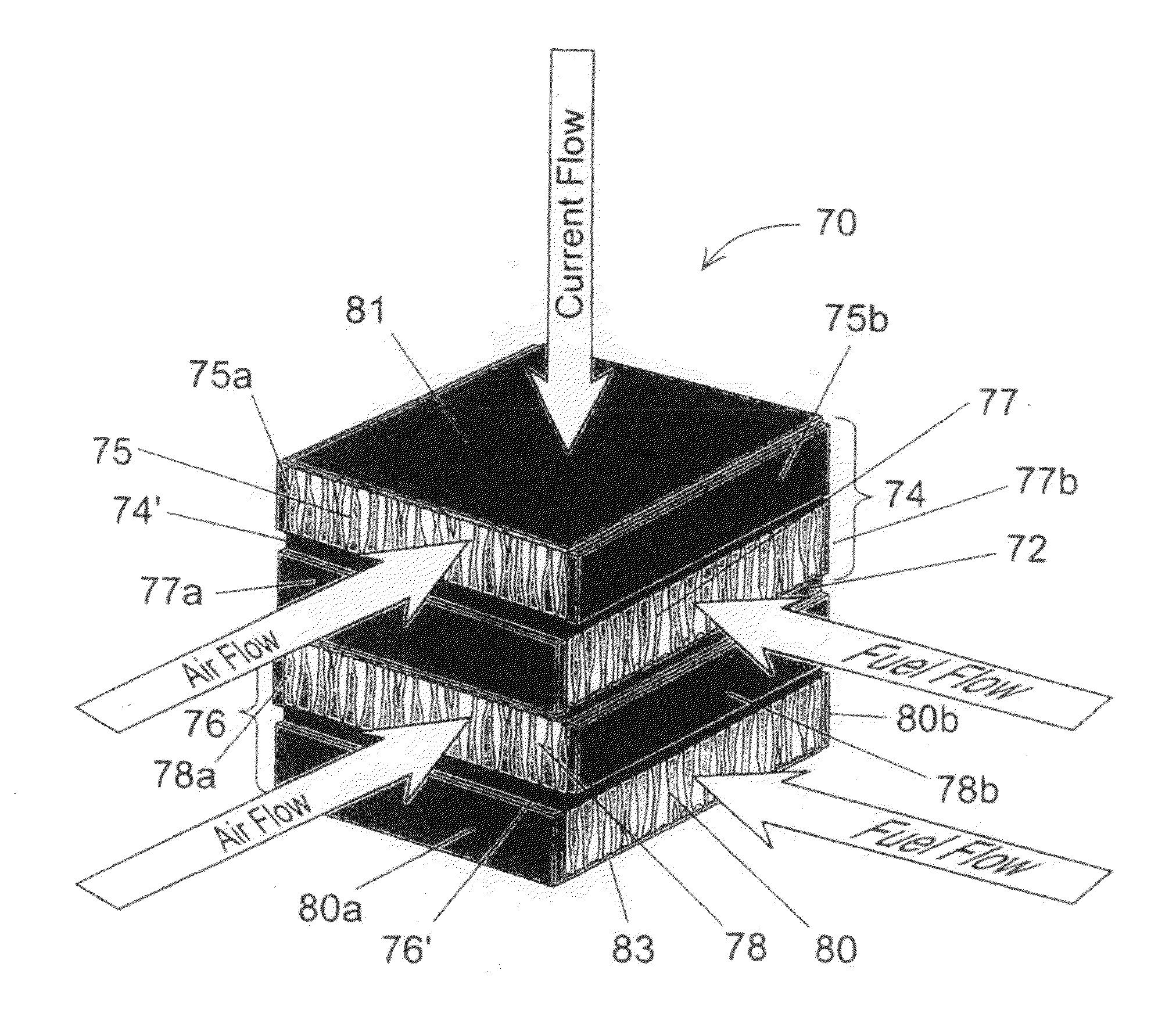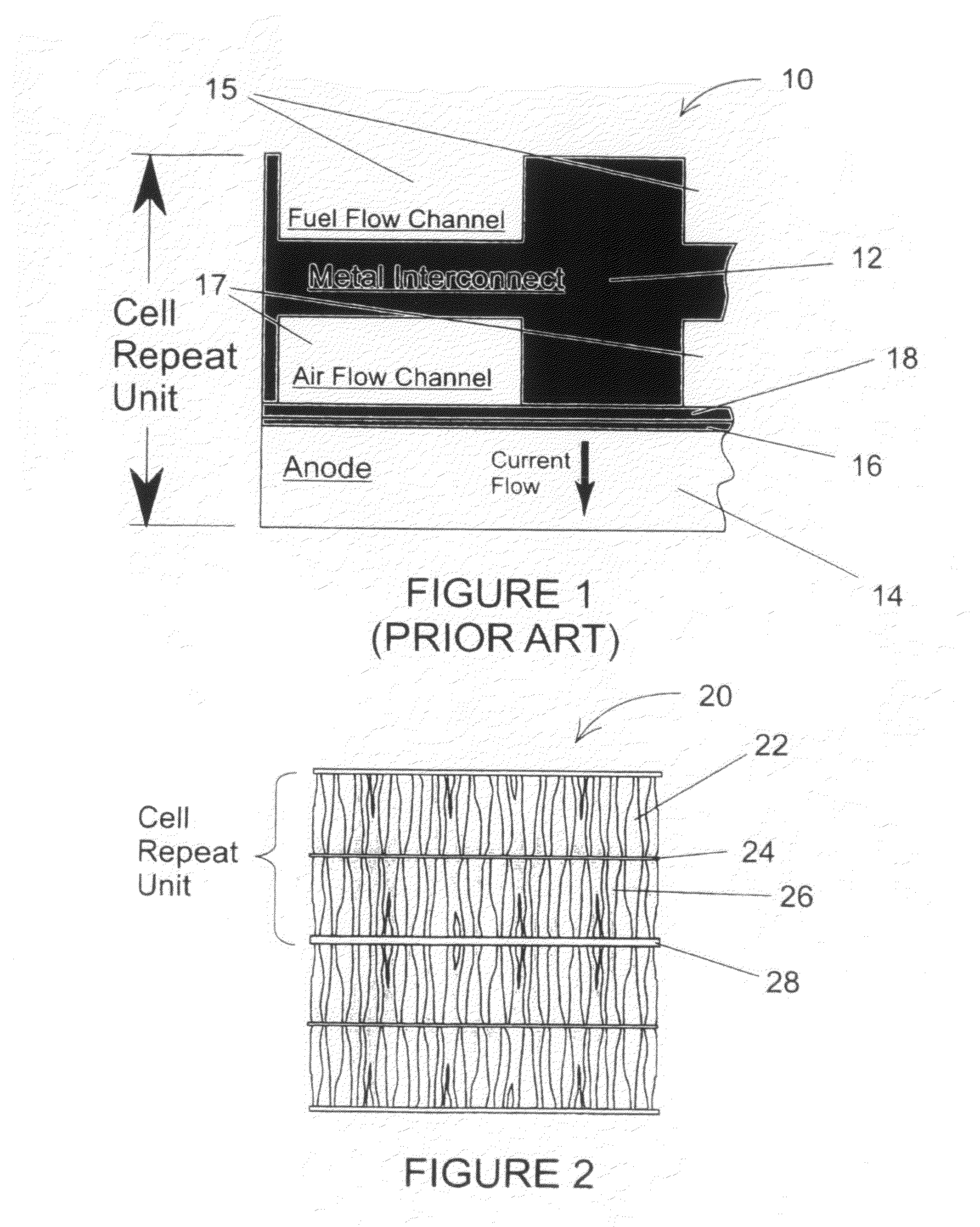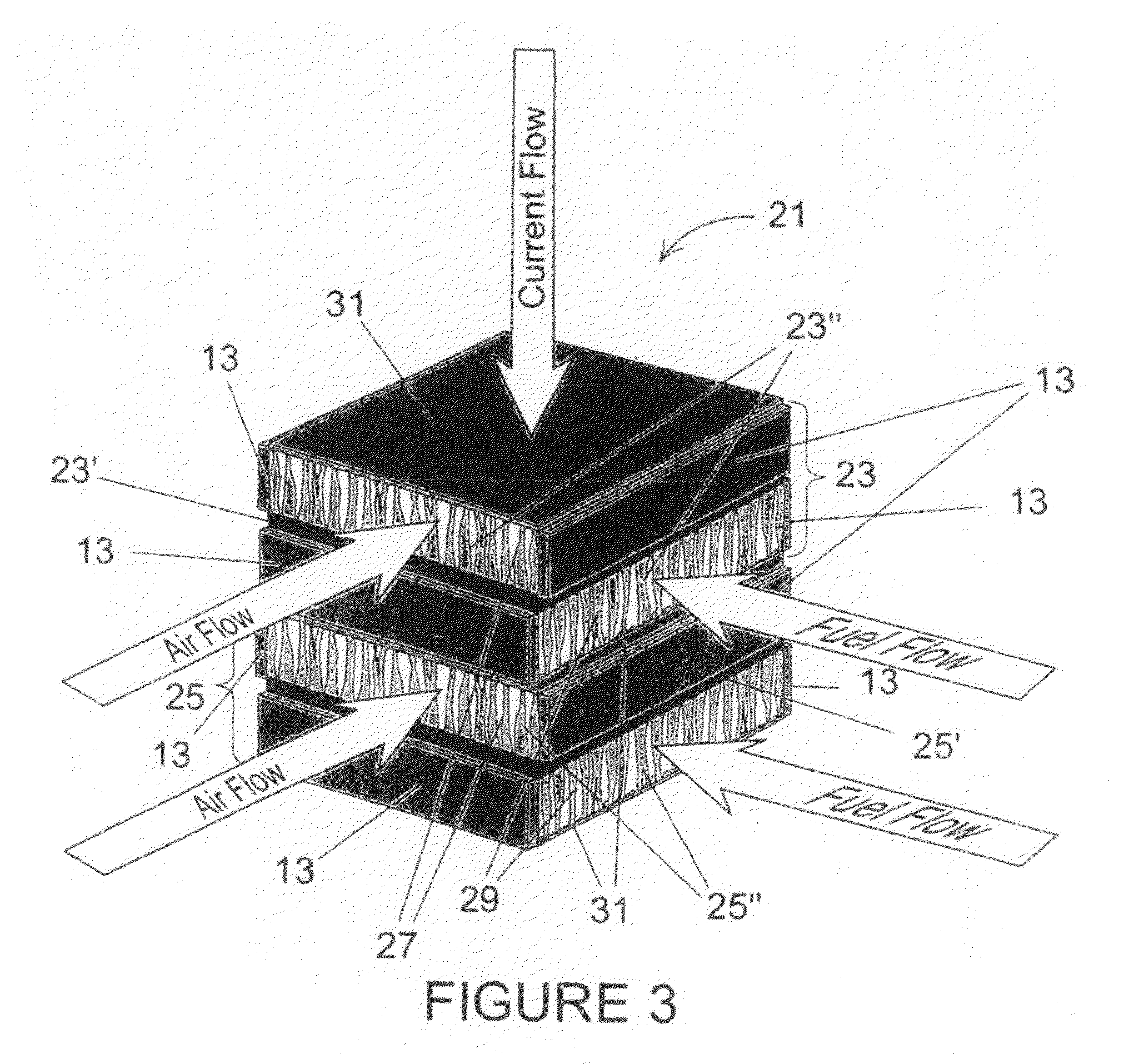[0008]The present invention is a monolithic solid oxide fuel cell stack comprising two or more symmetrical, bi-electrode supported fuel cell repeat units, each of which includes a first porous electrode scaffold, a second porous electrode scaffold, a thin electrolyte layer disposed between the first and the second porous electrode scaffolds, a thin coating of electrically conductive ceramic deposited upon opposing major outer surfaces of the first and second electrode scaffolds, and a first set of nonconductive edge sealants disposed upon each of two opposing edges of the first electrode scaffolds of each symmetrical, bi-electrode supported fuel cell repeat unit, and a second set of nonconductive edge sealants disposed upon each of two opposing edges of the second electrode scaffolds of each symmetrical, bi-electrode supported fuel cell repeat unit. The first porous electrode scaffold and the second porous electrode scaffold of each of the two or more symmetrical, bi-electrode supported fuel cell repeat units each comprises a plurality of graded pores, each having a small end and a large end, that are oriented more or less perpendicular to the thin electrolyte layer, and the graded pores of the first porous electrode scaffold and the graded pores of the second porous electrode scaffold of each of the two or more symmetrical, bi-electrode supported fuel cell repeat units are oriented such that the small end of each graded pore is adjacent the thin electrolyte layer of each of the two or more symmetrical, bi-electrode supported fuel cell repeat units and the large end of each graded pore is distal from the thin electrolyte layer. Said graded pores of the first porous electrode scaffold and the graded pores of the second porous electrode scaffold of each of the two or more symmetrical, bi-electrode supported fuel cell repeat units have characteristic small pore dimensions in the range of about 0.5 um to about 15 um, and has a preferred range of about 2 um to about 10 um, and the characteristic large pore dimensions in the range of about 25 um to about 125 um, and has a preferred range of about 50 um to about 100 um. The thin coating of electrically conductive ceramic deposited upon each of the opposing major outer surfaces of the first and second electrode scaffolds of each of the two or more symmetrical, bi-electrode supported fuel cell repeat units is made of doped-LaCr03. The first set of nonconductive edge sealants disposed upon each of two opposing edges of the first electrode scaffolds of each symmetrical, bi-electrode supported fuel cell repeat unit, and the second set of nonconductive edge sealants disposed upon each of two opposing edges of the second electrode scaffolds of each symmetrical, bi-electrode supported fuel cell repeat unit are made of a material selected from the group consisting essentially of ceramic and glass. The first porous electrode scaffolds of each of the two or more symmetrical, bi-electrode supported fuel cell repeat units and each of the second porous electrode scaffolds of each of the two or more symmetrical, bi-electrode supported fuel cell repeat units each has a thickness in the range of about 100 um to about 1500 um, and they have a preferred thickness in the range about 300 um to about 750 um. The thin electrolyte of each of the two or more symmetrical, bi-electrode supported fuel cell repeat units has a thickness in the range of about 2 um to about 200 um, with a preferred thickness in the range of about 5 um to about 25 um. The thin coating of electrically conductive ceramic deposited upon each of the opposing major outer surfaces of the first and second electrode scaffolds of each of the two or more symmetrical, bi-electrode supported fuel cell repeat units has a thickness in the range of about 2 um to about 200 um, with a preferred thickness in the range of about 5 um to about 25 um. The first electrode scaffold and the second electrode scaffold and the thin electrolyte layer of each of the two or more symmetrical, bi-electrode supported fuel cell repeat units are made essentially of a single solid oxide ceramic material, and it is an ionic conductor of ionic oxygen and has a fluorite like crystal structure and is selected from the group of materials consisting essentially of doped oxides of zirconium, cerium, bismuth, hafnium, thorium, indium, and uranium, and further, ionic conductors selected from the group of materials consisting essentially of yttria stabilized zirconia, partially stabilized zirconia, scandia stabilized zirconia, gadolinium doped ceria samarium doped ceria and yttrium doped ceria, and a perovskite oxide conductor, strontium and magnesium-doped lanthanum gallate or LaSrGaMg03. The ionic conductor might also be selected from the group of materials consisting essentially of conductors of protons. The two or more symmetrical, bi-electrode supported fuel cell repeat units, the first electrode scaffold, the second electrode scaffold, the thin electrolyte layer, the thin coating of electrically conductive ceramic deposited upon the opposing major outer surfaces of the first and second electrode scaffolds, the first set of edge sealants disposed upon each of two opposing edges of the first electrode scaffolds of each symmetrical, bi-electrode supported fuel cell repeat unit, and the second set of edge 5 sealants disposed upon each of two opposing edges of the second electrode scaffolds of each symmetrical, bi-electrode supported fuel cell repeat unit all have essentially the same coefficient of thermal expansion, and upon completion of assembling of all the aforementioned parts they are sintered into a single monolithic ceramic fuel cell framework. Each first electrode scaffold of each of the two or more symmetrical, bi-electrode supported fuel cell repeat units within the sintered monolithic ceramic framework has catalytically active anodic electrode properties, and each second electrode scaffold of each of the two or more symmetrical, bi-electrode supported fuel cell repeat units within the sintered monolithic ceramic framework has catalytically active cathodic electrode properties.
[0009]The invention is also a method of making a monolithic solid oxide fuel cell stack of two or more symmetrical bi-electrode supported solid oxide fuel cell repeat units, comprising the steps of freeze casting a ceramic slurry to create a graded pore tape having a plurality of graded pores, each of said pores having a first end with a small pore opening and a second end with a large pore opening, immediately followed by freeze drying the graded pore tape and then cutting the freeze dried graded pore tape into one pair of equal size first and second tape pieces for each of the two or more fuel cell repeat unit in the fuel cell stack, and coating each surface having small pore openings of each first and second graded pore tape piece of each pair with a thin layer of non-porous ceramic ink. The coated surfaces of each first and second graded pore tape piece are mated to form two or more layered structures, the surfaces of which having the large pore openings are coated with a thin aqueous layer of electrically conductive ceramic ink prior to mating the coated two or more layered structures into a single metastructure upon which a ceramic sealant over each of two opposing edges of each first piece of graded pore tape in each of the two or more layered structures in the metastructure and placing a ceramic sealant over each of two opposing edges of each second piece of graded pore tape in each of the two or more layered structures in the metastructure to form a green fuel cell framework which is then sintered into a monolithic structure that, subsequent to cooling can be subjected to solution and thermal treatment means to impart anodic electrode catalytic activity to each of the first pieces of graded pore tape in each of the two or more layers structures while solution and thermal treatment means are used to impart cathodic electrode catalytic activity to each of the second pieces of graded pore tape in each of the two or more layered structures.
[0010]The invention is yet also a sintered monolithic ceramic solid oxide fuel cell stack that is optimized for electrolysis of such materials as carbon dioxide and water, the fuel cell stack comprising two or more symmetrical, bi-electrode supported fuel cell repeat units each repeat unit including a graded pore anode, a graded pore cathode and a thin electrolyte layer disposed between the graded pore anode and cathode; a thin layer of electrically conductive ceramic disposed between each fuel cell repeat unit, a first set of nonconductive edge sealants disposed upon each of two opposing edges of the graded pore anode of each symmetrical, bi-electrode supported fuel cell repeat unit, and a second set of nonconductive edge sealants disposed upon each of two opposing edges of the graded pore cathode of each symmetrical, bi-electrode supported fuel cell repeat unit.
 Login to View More
Login to View More 


